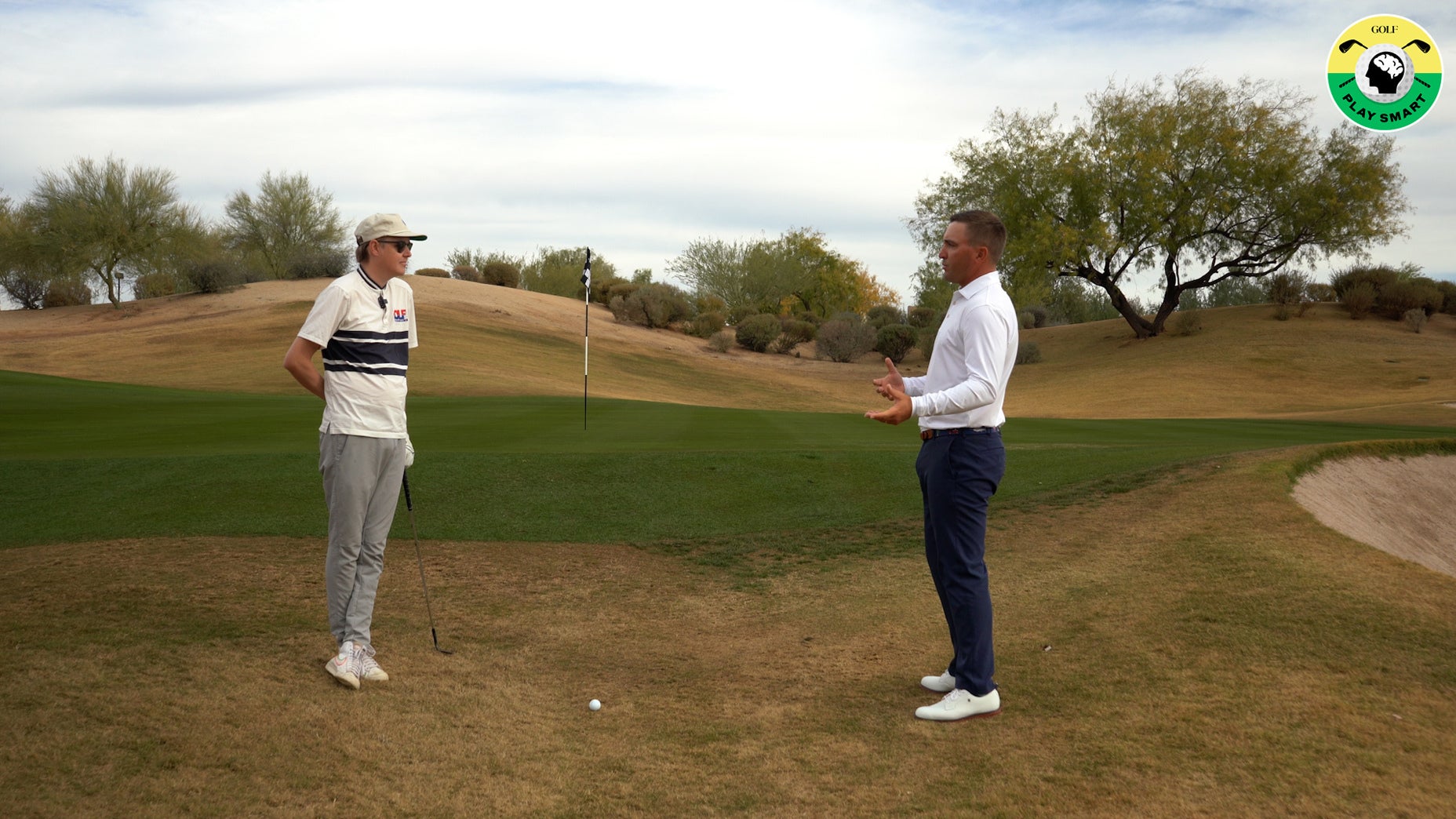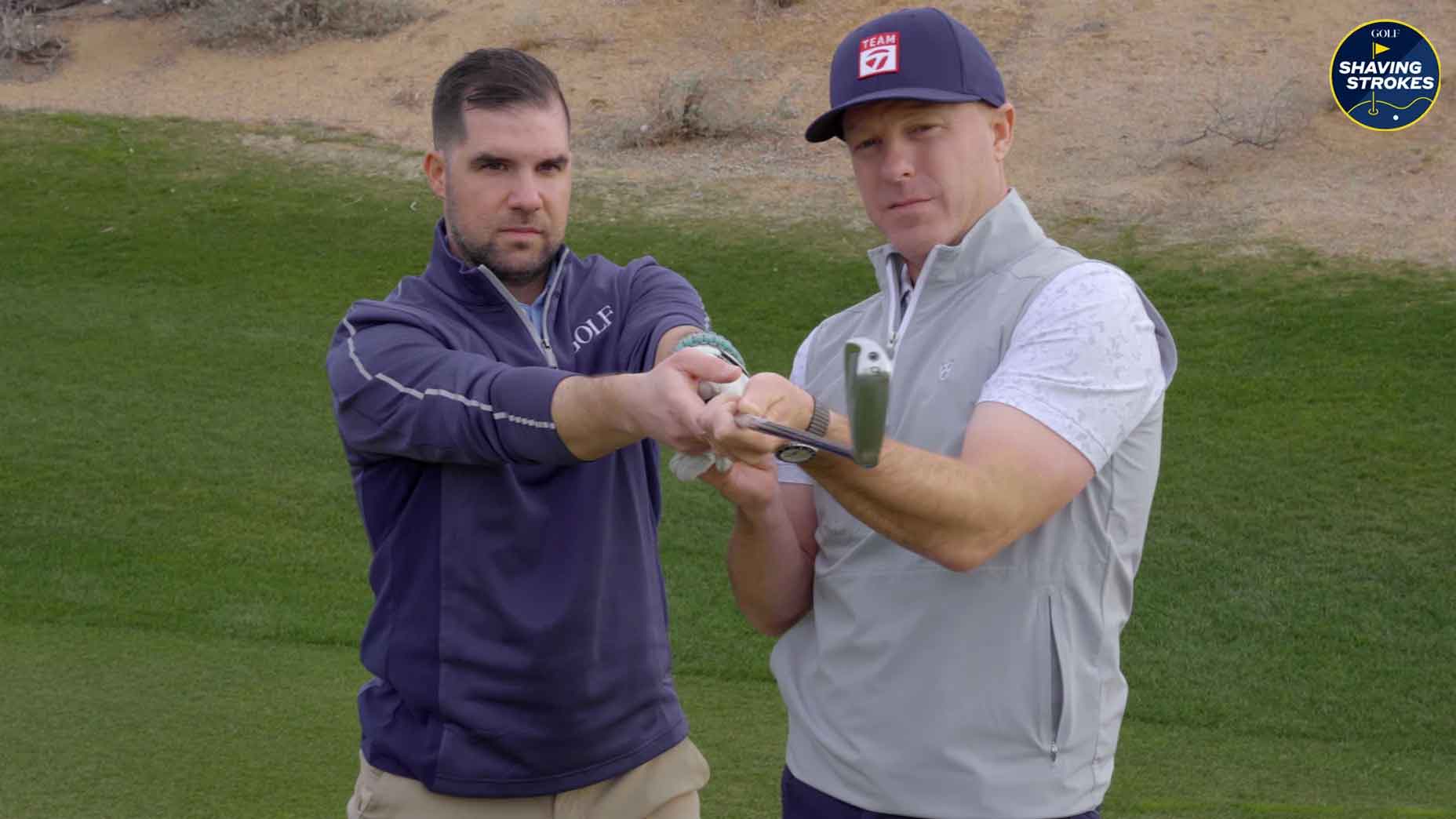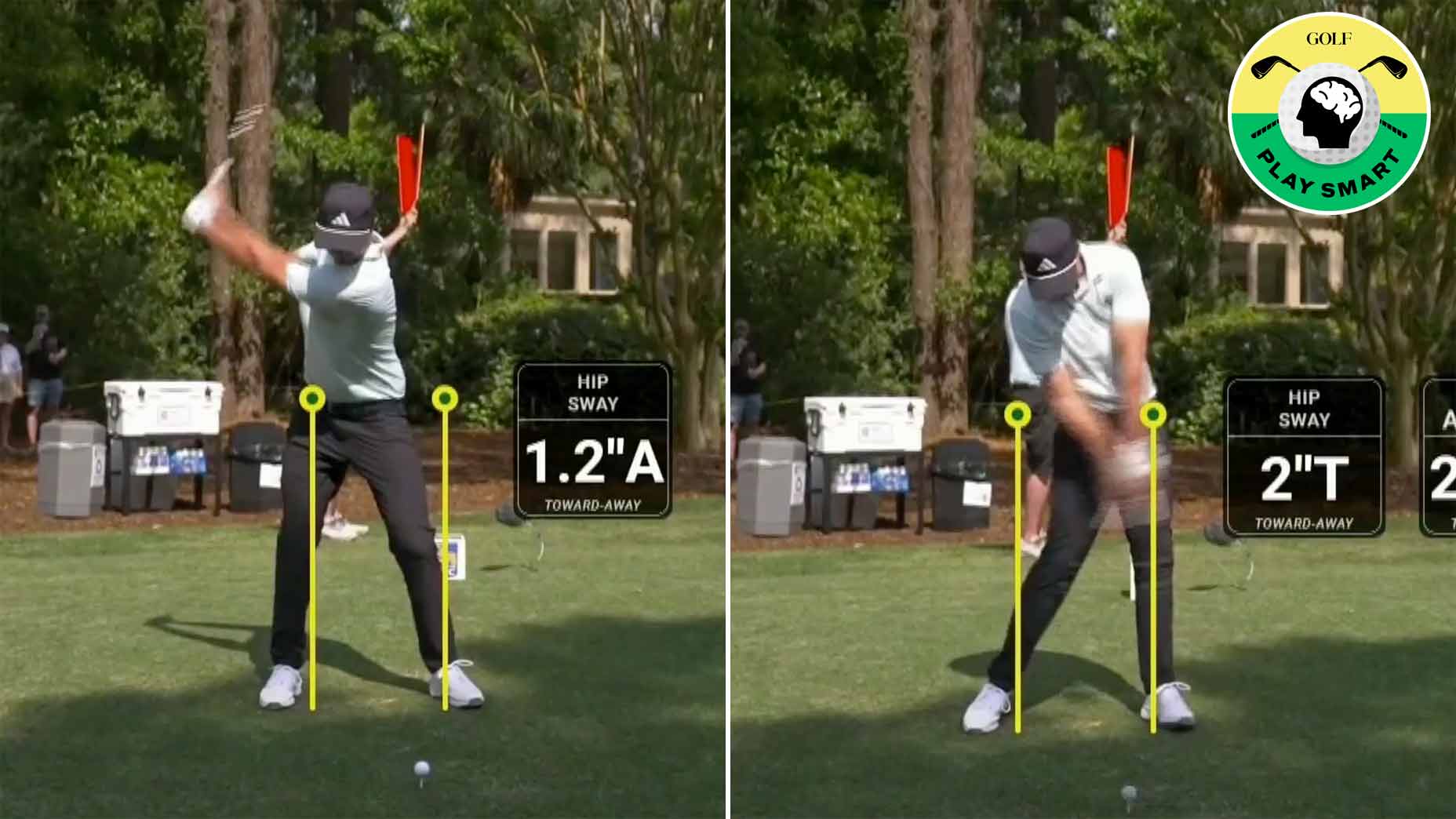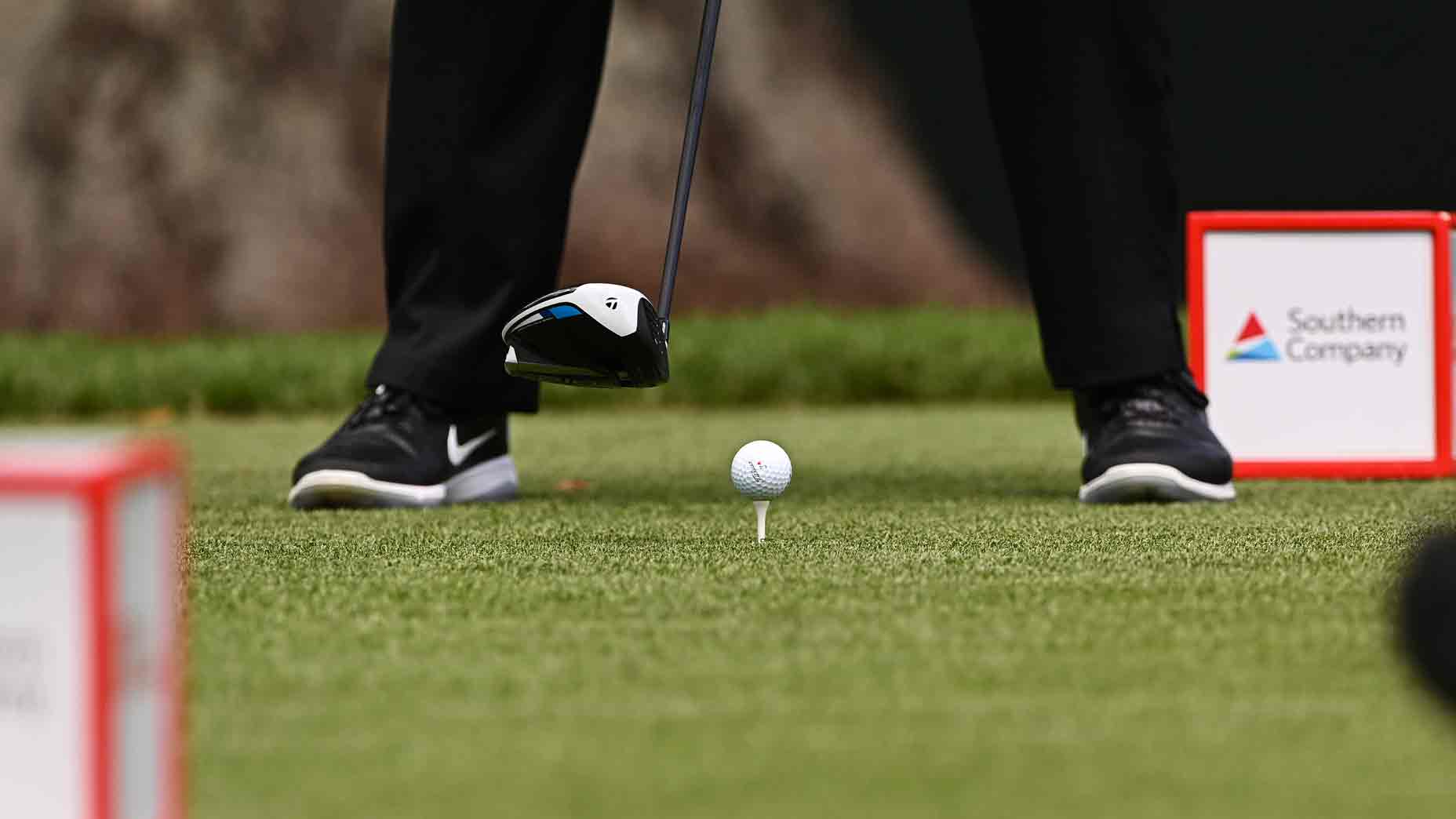With apologies to Verne Lundquist, have you ever in your life seen anything like Tiger Woods in full flow at the Masters? Augusta National has played an outsized role in creating the man, the myth, and the legend, from Woods’s iconic triumph in his professional Masters debut in 1997, to three more green jackets in a five-year span at the turn of the millennium. Time will tell if there are more highlights to come, but in the meantime, the best of Tiger at Augusta is a collection of thrilling—and teachable—moments.
1997, First Round, Hole No. 12, Second Shot

THE SITUATION: After a wobbly front-nine 40, Tiger’s tournament appeared over almost before it began. A birdie-par start to the back nine settled the ship, but a short-iron well long over the green to a front-left pin meant a diabolical chip toward Rae’s Creek, with bogey looking likely.
THE SHOT: Woods’s bump-and-run took two or three quick hops through the second cut, then rolled with perfect speed and line into the cup for a momentum-building birdie.

THE TAKEAWAY: “Most amateurs try to play this shot with too little loft,” says GOLF Top 100 Teacher Brian Manzella. “Tiger’s using a 9-iron or pitching wedge here, not a 7-iron. Loft gives you a little more spin for control. Also, looking down at more loft, even with your hands pushed a bit forward, means you’re not tempted to scoop it, which produces a bladed shot. Just play the ball back in your stance, make a short, firm stroke that brushes the grass, and keep the shaft in line with your left arm on the brief follow-through. If you chunk the shot, you’ve likely overdone the hands-ahead part somewhere in the swing.”
1997, First Round, Hole No. 15, Second Shot

THE SITUATION: Woods followed his short-game magic show at No. 12 (left) with a two-putt birdie on the par-5 13th hole. After parring No. 14, his titanic tee shot around the corner at the par-5 15th left just 151 yards to a still-dangerous front-left pin.
THE SHOT: Tiger hoisted a soaring pitching wedge that momentarily looked as if it might go in the hole before settling mere feet from the cup. (Sarazen’s famous 1935 double-eagle here remained safely unique, but the course didn’t, as “Tiger-proofing” would soon follow.) Woods poured in the eagle putt, moving from red figures (+1) to black (-1) en route to his remarkable back-nine 30, for one of the wildest opening-round 70s ever.

THE TAKEAWAY: “One key thing to notice is what Tiger doesn’t do, and what most pros don’t do—change the setup a bunch to hit the ball higher,” Manzella says. “They have a stock yardage and a high-end yardage. Adding mph to the swing without changing dynamic loft will produce a higher shot. The trick is to pivot harder and swing your hands and arms faster without rushing. Beyond that, you can see that Tiger finishes with his right arm higher than his left arm was at the top of his backswing, which helps create that “moon ball” trajectory. It’s a full release, with the butt of the club pointing toward the target on the way to the finish.”
2001, Second Round, Hole No. 8, Second Shot

THE SITUATION: With another, more pedestrian opening-round 70, Woods’s attempt to complete the Tiger Slam—holding all four major championships concurrently—had gotten off to a mild start, and he began the day five shots behind leader Chris DiMarco. Birdies at holes 3, 4 and 6 let everyone know that Tiger was on the prowl as he reached the uphill par-5 eighth.
THE SHOT: From the second cut on an uphill lie, 253 yards from the green, Woods took an almighty lash at the ball with his steel-shafted, steel-headed 3-wood. His own finish sent him stumbling backward a few steps…before he began to march forward and hand caddie Steve Williams his club. Tiger couldn’t see the ball—which bounced onto the green from the right, ending about 12 feet from the flagstick—but he knew he’d pulled off something that he alone could have. A two-putt birdie led to an outward-nine 33, and another 33 coming home allowed Woods to pull within two of the lead at the halfway point.

THE TAKEAWAY: “Given the club’s length and low loft, coming too much from the inside with a 3-wood off the fairway is the fast track to a low hook,” says Manzella. “Interestingly, at this point in his swing evolution, Tiger’s takeaway had his left arm moving away from his body, not inside, with the forearm rotating more (illustration, below). This set him up for getting the club out in front of his body sooner on the downswing, which helps get the ball up in the air. It’s a great first move for amateurs. Another one to copy: Woods’s high-hands, low-clubhead finish (above right). It’s a sign of a full release. You can’t launch it by holding back.”
2001, Final Round, Hole No. 11, Second Shot

THE SITUATION: The Masters doesn’t start until the back nine on Sunday, right? Maybe, maybe not, but the tension had certainly begun to redline as Woods, now the tournament co-leader, stood over his approach from an ideal spot in the right side of the fairway, 145 yards from the traditional Sunday pin, tucked hard against the pond to the left.
THE SHOT: A true Georgia peach: Woods’s controlled three-quarter 8-iron came in from the right, landed softly and spun left, taking a peek at the front edge of the cup before stopping at tap-in range. Woods’s birdie gave him a lead he wouldn’t relinquish, as he triumphed by two strokes over David Duval; the Tiger Slam was reality.

THE TAKEAWAY: “Tiger flighted the ball down on this shot. He took a narrow stance, which narrowed the arc of his swing,” Manzella says. “And I bet he took at least one club more than he needed while choking down—again, to lower the trajectory. Keeping your upper body “on top” of the ball a bit longer is another useful swing thought here. Of course, the main thing Tiger’s thinking is: Don’t go left! To limit the clubface over-rotating through impact (producing a left shot), keep your right arm working under the left and the club (illustration, right). Picture a swing where your right hand is gathering marbles from a vat in front of you, with your right palm facing up.”
2005, Final Round, Hole No. 16, Second Shot
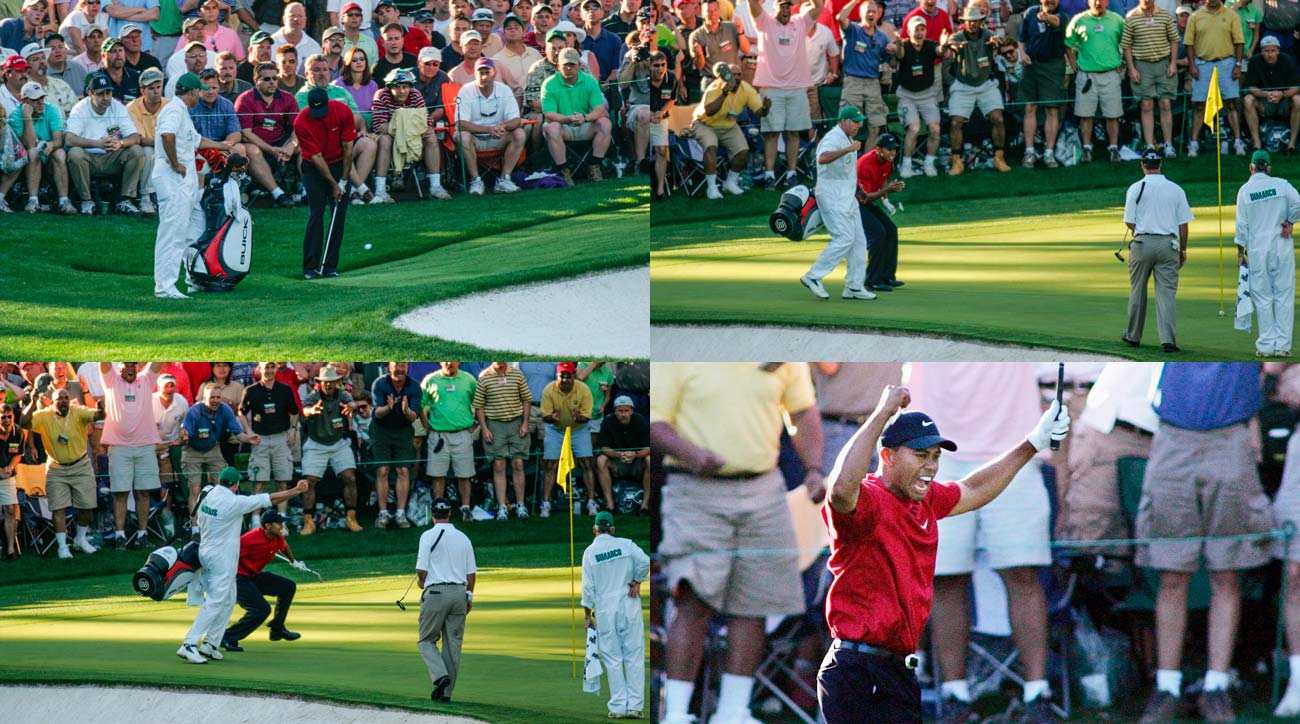
THE SITUATION: “There’s a good chance he doesn’t get it inside DiMarco’s ball.” So said color analyst Lanny Wadkins, assessing Woods’s predicament as he prepared to play his chip from long and left of the 16th green. Chris DiMarco, Woods’s playing partner, trailed Tiger’s lead by a stroke and had fully 15 feet for birdie; Wadkins wasn’t overselling the shot’s difficulty, enhanced as it was by taller grass behind Woods’s ball and the angle of the shot, perpendicular to a steeply sloped green—never mind intense pressure.
THE SHOT: “In your life, have you seen anything like that?!?” Verne Lundquist’s famous call came about 15 seconds after Woods played the chip and as the ball hung on the edge of, then fell in, the cup for birdie. Whether you prefer Woods’s recollection—that he aimed for a piece of light between the shadow of two trees—or caddie Williams’—that Tiger aimed for, and landed exactly atop, an old ball mark—the shot’s perfect precision is undeniable. If it’s not the greatest golf shot in history, it may well be the most dramatic.

THE TAKEAWAY: “The lesson is in Tiger’s practice swings,” Manzella says. “He takes several where the clubhead gets about ear-high—Tiger is trying to get a feel for the steeper angle of attack that will keep him from catching the higher grass behind the ball, so he can hit it crisply (illustration, left). On the actual shot, it’s a pro’s typical short, firm, “strike-a-match” pitch, with the ball a touch farther back in the stance to help produce ball-first contact. If you watch his preshot routine, he’s laser-focused on his landing spot. The final thing you want to look at before a chip or a pitch is the landing spot. Remember, your last thought prior to any short-game shot should be, “How hard do I want to hit this ball to get it to my spot?””
2005, Final Round, Playoff, Hole No. 18, Third Shot

THE SITUATION: Woods’s bogey-bogey finish following his heroics on the 16th shocked everyone, and indeed he only made it into a playoff with DiMarco by millimeters, as the dogged competitor’s chip just missed going in on the final hole of regulation. Tiger instantly regrouped, with two near-perfect shots—3-wood drive, 8-iron approach—leaving him 18 feet for the green jacket.
THE SHOT: When Phil Mickelson’s similar putt to break his Masters luck the year prior fell in the left edge, golf fans’ joy was magnified by a mix of relief and surprise—he finally pulled it off! (“Oh, my god,” said Mickelson as he walked off the green with his wife and kids.) When Tiger poured his winning putt dead-center into the cup, it seemed the only realistic outcome.

THE TAKEAWAY: “Whether it’s a putt to win the fourth flight of the club championship, to break 100 for the first time, or to finally beat Dad, you need to be like a hit man,” says Manzella. “That cold-blooded, “nothing personal” mentality comes from a focus on controlling what you can control. Nobody in golf history has been better at that than Tiger. Most people try to make a putt—Tiger focuses all his attention on making a stroke. While he knows exactly what’s at stake, he never overdoes it. You don’t see him taking forever, looking at it from 27 angles. He also doesn’t try to trick himself into thinking it’s not a huge putt by rushing. Tiger knows that making the best stroke he can make is all he can do, and the chips will fall where they may—regardless of the situation. More often than not, they’ve fallen center-cut.”


